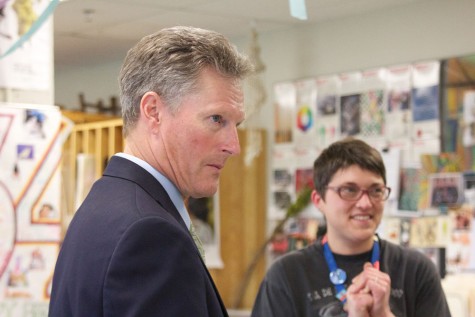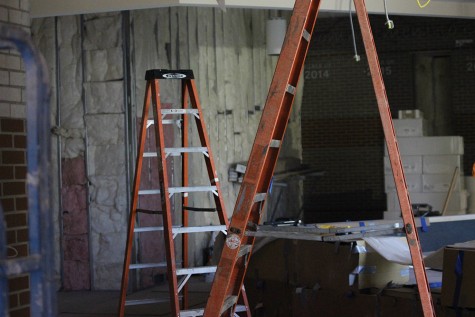Teaching to the Test: Staffers debate AP approach
By the Book
by Elizabeth Patton
At the beginning of every school year, students enter Advanced Placement (AP) classes, prepared for nine months of hard work in anticipation of the AP tests in May.
To learn all of the necessary curriculum with only four class periods a week, AP students must work under time constraints that require teachers to stick to the AP curriculum and recommended schedule. These restraints exemplify the importance of focusing class time on curriculum, rather than outside knowledge students can explore on their own.
AP students are consciously tackling much more difficult work than other students, so rather than spending valuable class time on outside discussions, they should be provided the tools to handle the AP test that holds the potential to save thousands of dollars in their collegiate career.
Senior Sophie Westbrook, who boasts a perfect PSAT score, as well as an acceptance letter from Harvard, has taken many AP classes in her years at Free State.
“I wish the AP classes were more standardized,” Westbrook said. “Right now, teachers have a lot of leeway, so some of them are very much about talking and trying to learn together, but you have other classes, specifically science and math classes, that are teaching to the test.”
The way math and science classes hold tight to a rigid curriculum-based schedule to ensure students are fully prepared for their AP test is a standard that should be more forcibly enforced across all AP courses, as students should be offered the same chance for AP success. AP courses use a curriculum that requires students to take an analytical approach, therefore teaching students to expand their way of thinking beyond the typical high school demand.
The College Board has mandated that while, “each individual school must develop its own curriculum for courses labeled ‘AP,’ each AP course has a set of curricular and resource expectations that college and secondary school faculty have established for each AP course.”
The requirement of high school classes’ focus on strictly AP curriculum has been a long-lasting and clearly effective policy.
According to the College Board’s most recent data analysis, “20.1 percent of public high school graduates in the class of 2013 earned a three or higher on an AP Exam, compared to 12.2 percent of graduates in the class of 2003.” AP tests are scored on a one to five scale, with five being the highest possible score. At most institutes that accept AP credit, anywhere from a three to a five on an AP test is sufficient to receive credit, as the student has proved he or she has an adequate understanding of the topic.
Juniors Ethan Kallenberger and Kierstin Hutfles each juggle three AP classes, and their biggest concern regarding outside curriculum is the time crunch they have in the classes.
“It would be great to go more in-depth on topics that the AP test doesn’t cover as much or that we find more interesting, but in the end what really counts is how you score on the AP test,” Hutfles said.
Kallenberger agrees.
“The problem is, we don’t have enough time in the year to do both,” Kallenberger said. “You have to get a lot of stuff in, in not a lot of time.”
AP students are some of the most driven of the high school community. They deserve the opportunity to succeed at an AP level through sticking close to the AP curriculum schedule to receive as much information as possible, in already highly analytic classes.
Beyond the Norm
by Kenneth Palmer
Day in and day out, we are asked to read a textbook, view a powerpoint presentation and follow the machinations of the AP curriculum. Sure, we learn valuable information, but we aren’t expected to think beyond the material given.
While students who already think critically may not be negatively affected by this system, others are just pumped with information. Maybe they earn good or even great scores, and maybe they save some money. However, AP curriculum does little to further critical-thinking skills necessary in and beyond college. There needs to be a space for challenging thought for students who, by no fault of their own, have not had these influences.
This is not to say teachers are at fault; they have little choice in the matter. They do their best to work within the system, and many teachers try to encourage in-depth analysis, but time restrictions limit how much can be done.
With the appeal of reduced educational costs, it is not always easy to see the harmful attitude espoused by the College Board. It is vital, however, to remember that good test scores and intellectual exploration are not mutually-exclusive. We always need facts, but we also need thought.
The problem arises when students are used to putting in a certain effort and getting a specific output. Even if the students obtain a good job without strong critical thinking skills, they learn a certain complacency. These satisfied, apathetic students become an uninterested, unquestioning citizenry.
If we condition people to believe that one is rewarded for taking in and reciting the fact they are presented without objection, we subtly encourage a mentality that doesn’t criticize information. Schools powerfully influence the way society thinks, and if education doesn’t include learning to question the status quo, then citizens are vulnerable to manipulation.
Even if a few people break from this box and attempt to lead, their efforts are only really scrutinized by a small group of other people who, somewhere along the way, learned to think critically. These people become the politicians, the scientists and the people who get to make decisions, and they have the potential to take advantage the people who have not developed the habit of criticism. Critical thought is the best tool against deception by those with power.
This may seem like a dystopian exaggeration, but if one does not learn to challenge ideas and think without limitations, there is no amount of pure information that can protect him or her from manipulative politics, pseudoscience or other oppressive systems and ideas.
Learning to challenge the world’s standards starts in high school or earlier. A few leaders cannot drag everyone forward kicking and screaming; people must be active and open to change, and where else but the classroom will people learn to think twice about a questionable headline or a skewed fact?
People need a strong foundation of independent thought, and the AP system, a symptom of a broader problem, does not foster this. We must interweave hard facts with hard thought, and if we opt for the easy way out, then we create a nation of unthinking people, ill-equipped to fend for themselves in the midst of a world of predatory, calculating groups that will outthink them at every turn.
Your donation will support the student journalists of Lawrence Free State High School. Your contribution will allow us to purchase equipment and cover our annual website hosting costs.










